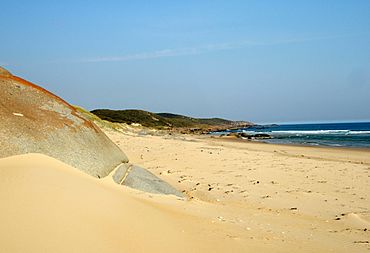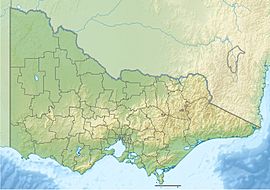Croajingolong National Park facts for kids
Quick facts for kids Croajingolong National ParkVictoria |
|
|---|---|
|
IUCN Category II (National Park)
|
|

A beach in the Croajingolong National Park; looking north towards Rame Head.
|
|
| Nearest town or city | Mallacoota |
| Established | 26 April 1979 |
| Area | 883.55 km2 (341.1 sq mi) |
| Managing authorities | Parks Victoria |
| Website | Croajingolong National Park |
| See also | Protected areas of Victoria |
The Croajingolong National Park is a huge coastal park in Victoria, Australia. It's a special place where nature is protected. This amazing park covers about 88,355 hectares (that's like 218,330 football fields!). You can find it about 450 kilometers east of Melbourne and 500 kilometers south of Sydney.
The name Croajingolong comes from the Aboriginal Krauatungalung language. The words galung and kraua mean "belonging to the east".
Exploring Croajingolong National Park
This park has a long, narrow shape. It stretches along the coast, next to the Tasman Sea of the South Pacific Ocean. To its west is the Bemm River, and to its east is the town of Mallacoota. The northern part of the park has thick bushland and small hills.
The park is about 80 kilometers long and 20 kilometers wide. Its total area is around 875 square kilometers. A cool path called the Wilderness Coast Walk goes for 100 kilometers. It takes you along beaches, through open areas, and around rocky cliffs.
Croajingolong National Park is very important for nature. It joins with the Nadgee Nature Reserve in New South Wales. Together, they form one of only twelve "World Biosphere areas" in Australia. This means they are special places where nature is looked after carefully. They protect many different ecosystems (natural communities), habitats (animal homes), and gene pools (genetic variety).
Important Bird Area
The eastern part of the park is known as the Nadgee to Mallacoota Inlet Important Bird Area. BirdLife International gave it this name because it's home to special birds. These include eastern bristlebirds and pilotbirds, along with many other important animals.
Things to See and Do
Croajingolong's beautiful landscapes are so important that UNESCO (a part of the United Nations) named it a World Biosphere Reserve in 1977. The park has an amazing variety of life. You can find almost 1,000 types of native plants here. There are also 315 different kinds of animals.
The park's coast has rocky areas, long sandy beaches, and sand dunes. It also has freshwater rivers. This makes it a great place for many outdoor activities. You can go hiking, walking, swimming, diving, and snorkeling. Sea kayaking is also a popular way to explore the water.
A fun way to see the park's wild nature is the Wilderness Coast Walk. This path is 45 kilometers long. It goes from the Thurra River camping area to Shipwreck Creek.
Here are some popular spots inside the park:
- Point Hicks and its famous lighthouse
- Tamboon Inlet, a small resort town
- Amazing sand dunes at Thurra River
- Lake Elusive near Wingan Inlet
- Mount Everard
- Rame Head, a rocky headland
You can find camping spots at Wingan Inlet, Shipwreck Creek, and Peachtree Creek. You can drive to all of these. There are also campsites at Mueller Inlet and Thurra River. Most campgrounds have picnic areas and places for campfires.
Nearby towns include Mallacoota, Genoa, Cann River, Bemm River, and Orbost.


